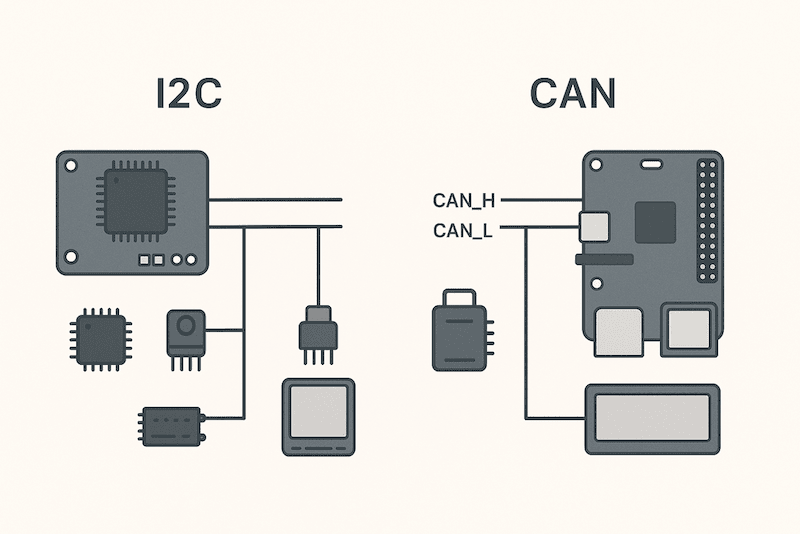Recent Posts
I2C vs. CAN Bus: Choosing the Right Communication Protocol for Your Embedded System
Posted by on
 In the world of embedded systems, choosing the right communication protocol can make or break your project's performance, scalability, and reliability. Among the most widely used protocols are I2C (Inter-Integrated Circuit) and CAN (Controller Area Network). Each has its own strengths, limitations, and ideal use cases—so how do you choose the right one for your design?
In the world of embedded systems, choosing the right communication protocol can make or break your project's performance, scalability, and reliability. Among the most widely used protocols are I2C (Inter-Integrated Circuit) and CAN (Controller Area Network). Each has its own strengths, limitations, and ideal use cases—so how do you choose the right one for your design?
In this post, we’ll break down the key differences between I2C and CAN Bus, focusing on their practical implementation in microcontroller platforms like STM32, Arduino, and Raspberry Pi. Whether you're building a home automation system or designing industrial control hardware, understanding these protocols is essential.
What Is I2C?
I2C is a simple, low-speed serial communication protocol used primarily for short-distance, board-level communication between microcontrollers and peripherals. It uses just two lines—SDA (data) and SCL (clock)—to connect multiple devices in a master-slave configuration.
-
Speed: Typically 100 kHz (Standard Mode), 400 kHz (Fast Mode), and up to 3.4 MHz (High-Speed Mode).
-
Distance: Less than 1 meter; limited by bus capacitance.
-
Fault Tolerance: Minimal; sensitive to noise and lacks robust error handling.
-
Power Consumption: Low; ideal for low-power designs.
-
Hardware Simplicity: Minimal wiring and no transceivers required.
Best for simple sensor networks or connecting EEPROMs, RTCs, and other onboard components.
What Is CAN Bus?
CAN (Controller Area Network) is a robust, high-reliability protocol originally designed for automotive applications. It excels in multi-node, real-time communication across longer distances.
-
Speed: Up to 1 Mbps for standard CAN, and up to 8 Mbps with CAN FD.
-
Distance: Up to 40 meters at 1 Mbps; up to 500 meters at lower speeds.
-
Fault Tolerance: High; includes CRC checks, retransmissions, and node isolation.
-
Power Consumption: Moderate; transceivers add overhead.
-
Hardware Complexity: Requires external transceivers (e.g., MCP2551), especially for Arduino and Raspberry Pi.
Best for automotive, industrial control, and systems requiring high reliability and noise resistance.
Key Differences at a Glance
| Feature | I2C | CAN Bus |
|---|---|---|
| Data Rate | Up to 3.4 Mbps | 1 Mbps (standard), 8 Mbps (CAN FD) |
| Max Distance | <1 meter | Up to 500 meters |
| Wiring | 2 wires | 2 wires + transceiver |
| Topology | Master-slave | Multi-master, message-based |
| Fault Tolerance | Low | High |
| Typical Use Case | Sensors, displays, RTCs | Automotive, robotics, industry |
Platform Integration
-
STM32: Most STM32 chips support both I2C and CAN (often with built-in CAN controllers). Great for scalable systems.
-
Arduino: Native I2C support across nearly all models. CAN requires a shield (e.g., MCP2515 with transceiver).
-
Raspberry Pi: I2C is supported on GPIO by default. CAN requires SPI CAN modules or HATs with drivers.
Which One Should You Use?
-
Use I2C when your devices are on the same board or very close together, and you need a low-cost, low-power solution with minimal wiring.
-
Use CAN Bus when your system requires reliable communication over longer distances, especially with multiple nodes and in electrically noisy environments.
Final Thoughts
Both I2C and CAN Bus are essential tools in the embedded engineer’s toolbox. They’re not competitors—they’re complementary, each suited to different tasks. The key is understanding your project's performance, distance, and reliability requirements before selecting a protocol.
Whether you're prototyping on an Arduino, scaling with STM32, or deploying industrial applications with Raspberry Pi, mastering these protocols opens the door to more capable and professional embedded designs.
 If you work with embedded systems, you’ll inevitably encounter the ubiquitous Inter-Integrated Circuit bus (I²C or IIC)—a widely used serial protocol for connecting integrated circuits within electronic systems. In The Book of I2C, bestselling author Randall Hyde leverages over 40 years of industry experience to deliver the first comprehensive guide to this essential technology, helping you design and program I2C-based systems with confidence.
If you work with embedded systems, you’ll inevitably encounter the ubiquitous Inter-Integrated Circuit bus (I²C or IIC)—a widely used serial protocol for connecting integrated circuits within electronic systems. In The Book of I2C, bestselling author Randall Hyde leverages over 40 years of industry experience to deliver the first comprehensive guide to this essential technology, helping you design and program I2C-based systems with confidence.
Featuring over 100 detailed diagrams and annotated code examples, the book explores I2C implementations on platforms like Arduino, Teensy, and Raspberry Pi. It also covers I2C variants and a wide range of common peripheral ICs, complete with hands-on programming examples. Whether you're a hardware hacker, electronics enthusiast, or software engineer, this in-depth reference offers practical insight and serves as an indispensable companion for interfacing real-world devices with I2C microcontrollers. More information...
 Loading... Please wait...
Loading... Please wait...
